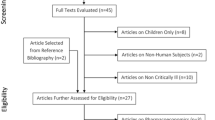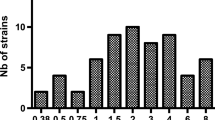Abstract
Background There is lack of information on the efficacy and safety of piperacillin–tazobactam administered by continuous infusion. Objective The aim of this study was to investigate whether continuous infusion of piperacillin–tazobactam is superior in terms of efficacy to a 30 % higher dose administered by intermittent infusion to treat suspected or confirmed infection due to Pseudomonas aeruginosa. Setting Multicenter clinical trial with 11 third level Spanish hospitals. Method Randomized, double-blind parallel-group clinical trial, controlled by conventional administration of the drug. Patients randomly assigned in a 1:1 ratio to receive piperacillin–tazobactam as continuous infusion (CI) or intermittent (II). Main outcome measure Primary efficacy endpoint was percentage of patients having a satisfactory clinical response at completion of treatment, defined as clinical cure or clinical improvement. Adverse events were reported. Results 78 patients were included, 40 in the CI group and 38 in the II group. Mean (standard deviation) duration of treatment was 7 (±4.44) days. 58 patients (74.4 %) experienced cure or improvement at the end of the treatment. There were no statistical differences in cure rates between the two treatment arms and no adverse events were reported. Conclusion Continuous infusion of piperacillin–tazobactam is an alternative administration drug method at least similar in efficacy and safety to conventional intermittent infusion. Multivariate analysis is needed to determine whether continuous administration might be more beneficial than intermittent in certain patient subgroups.


Similar content being viewed by others
References
Jhee SS, Kern JW, Burm JP, Yellin AE, Gill MA. Piperacillin–tazobactam pharmacokinetics in patients with intraabdominal infections. Pharmacotherapy. 1995;15:472–8.
Auclair B, Ducharme MP. Piperacillin and tazobactam exhibit linear pharmacokinetics after multiple standard clinical doses. Antimicrob Agents Chemother. 1999;43:1465–8.
Facca BF, Trisenberg SN, Barr LL. Population pharmacokinetics of continuous infusion piperacillin–tazobactam. J Infect Dis Pharmacother. 2002;5:51–67.
Tazocel (Piperacillin–tazobactam) product insert. http://www.aemps.gob.es/cima/pdfs/es/ft/59660/FT_59660.pdf. Accessed 13 Jan 2015.
Falagas ME, Tansarli GS, Ikawa K, Vardakas KZ. Clinical outcomes with extended or continuous versus short-term intravenous infusion of carbapenems and piperacillin/tazobactam: a systematic review and meta-analysis. Clin Infect Dis. 2013;56:272–82.
Daenen S, Erjavec Z, Uges DR, De Vries-Hospers HG, De Jonge P, Halie MR. Continuous infusion of ceftazidime in febrile neutropenic patients with acute myeloid leukemia. Eur J Clin Microb Infec Dis. 1995;14:188–92.
David TJ, Devlin J (1989). Continuous infusion of ceftazidime in cystic fibrosis. Lancet. i:1454–55.
Dulhunty JM, Roberts JA, Davis JS, et al. Continuous infusion of beta-lactam antibiotics in severe sepsis: a multicenter double-blind, randomized controlled trial. Clin Infect Dis. 2013;56:236–44.
Nicolau DP, McNabb J, Lacy MK, Quintiliani R, Nightingale CH. Continuous versus intermittent administration of ceftazidime in intensive care unit patients with nosocomial pneumonia. Int J Antimicrob Agents. 2001;17:497–504.
Ambrose PG, Quindliani R, Nightingale CH, Nicolau DP. Continuous versus intermittent infusión of cefuroxime for the treatment of community-acquired pneumonia. Infect Dis Clin Prac. 1998;7:463–70.
Hanes SI, Wood GC, Herring V, et al. Intermittent and continuous ceftazidime infusion in critically ill trauma patients. Am J Surg. 2000;179:436–40.
Hyatt JM, McKinnon, Zimmer GS, Schentag JJ. The importance of pharmacokinetic/phamacodynamic surrogate markers to outcome focus on antibacterial agents. Clin Phamacokinet. 1995;28:143–60.
Eagle H, Musselman AD. The rate of bacterial action of penicillin in vitro as a function of its concentration, and its paradoxically reduced activity at high concentrations against certain organisms. J Exp Med. 1948;88:99–131.
Jason R, Webb S, Paterson D, et al. A systematic review on clinical benefits of continuous administration of lactam antibiotics. Crit Care Med. 2009;37:2071–8.
Roberts JA, Webb S, Paterson D, Ho KM, Lipman J. Continuous infusion of B-lactam antibiotics in severe infections: a review of its role. Int J Antimicrob Agents. 2007;30:11–8.
Grant EM, Kuti JL, Nicolau DP, Nightingale C, Quintiliani R. Clinical efficacy and pharmacoeconomics of a continuous-infusion piperacillin–tazobactam program in a large community teaching hospital. Pharmacotherapy. 2002;22:471–83.
Roberts JA, Roberts MS, Robertson TA, Dalley AJ, Lipman J. Piperacillin penetration into tissue of critically ill patients with sepsis–bolus versus continuous administration? Crit Care Med. 2009;37:926–33.
Lodise TP Jr, Lomaestro B, Drusano GL. Piperacillin–tazobactam for Pseudomonas aeruginosa infection: clinical implications of an extended-infusion dosing strategy. Clin Infect Dis. 2007;44:357–63.
Acknowledgments
We thank the staff of the Pharmacy Department of Virgen del Rocio Hospital for their collaboration with this study and all the staff of each participating hospital.
Funding
The Ministry of Health and Social Policy of Spain supported this work within the 2010 initiative for funding of independent clinical research in medications, with no commercial interest (File Number: EC10-288).
Author information
Authors and Affiliations
Corresponding author
Ethics declarations
Conflicts of interest
The authors declare they have not conflicts of interest.
Rights and permissions
About this article
Cite this article
Cotrina-Luque, J., Gil-Navarro, M.V., Acosta-García, H. et al. Continuous versus intermittent piperacillin/tazobactam infusion in infection due to or suspected pseudomonas aeruginosa . Int J Clin Pharm 38, 70–79 (2016). https://doi.org/10.1007/s11096-015-0208-y
Received:
Accepted:
Published:
Issue Date:
DOI: https://doi.org/10.1007/s11096-015-0208-y




